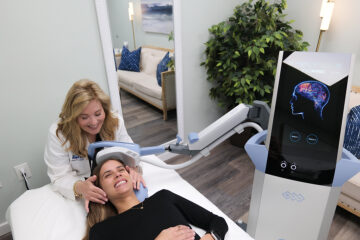What to Do About Us?

What to Do About Us?
The importance of planning for our own future
Six years ago, I wrote “What to Do About Mom and Dad?” — an article about the challenges faced by grown children and the elderly parents who need increasing care. My mother-in-law, for example, was in her 90s at the time, and had reluctantly moved from her longtime home on the East Coast to be closer to her family in the West — a major transition for all involved. My husband and I were also part of the so-called “sandwich generation,” caring not just for aging parents, but children or teenagers still at home. Add two demanding careers, housekeeping, kids’ “shuttle services” to school, sports, and other activities — and more recently, grandchildren! As we all know, life, with its many blessings, can be both challenging and rewarding.
As the years have passed, filled with both painful passages and unspeakable joy, my husband and I have learned that even as we care for others, we need to plan for our future. What to do about us? While it could be years before we need help ourselves, we have begun the process of getting our own house in order.

Author Ken Druck strikes a similar chord in his new book, Courageous Aging, Your Best Years Ever Reimagined, which challenges myths and negative stereotypes about aging and urges us to do a self-audit to help create “a vision for the life” we want to lead.
“Putting our houses in order starts with taking stock of our thoughts and feelings about getting older,” he writes. “It involves tending to sensitive matters in our relationships, those that bring our greatest joys, and our deepest sorrows. Putting our houses in order means sorting through and updating our goals and aspirations — because yes, each season of life affords us new opportunities for setting goals and living out our dreams. And putting our house in order means unveiling and paying close attention to what matters most in our heart of hearts.”
It also means practical considerations such as drafting a will, a living trust, and an advanced health care directive that goes beyond a “do not resuscitate order,” detailing your health care preferences and designating a health care agent to make decisions on your behalf. “It’s the most important decision you’ll ever make,” says Dr. Jennifer Brokaw, a board-certified emergency physician turned private consultant and patient advocate, who spoke earlier this year at the annual Mabel Jessop Women’s Financial Symposium organized by Rady Children’s Hospital. Dr. Brokaw has helped her father, the NBC newsman and author Tom Brokaw, navigate multiple myeloma, an incurable but treatable form of blood cancer. She also understands first-hand about the difficulties and cost of finding long-term care as an advocate for an uncle who died of Alzheimer’s Disease. Dr. Brokaw co-founded C2it Health to help other families find care.
Putting your house in order might also mean cleaning house, as in selling, donating or giving away things collected over a lifetime. “We have a responsibility to do that,” says Druck, so our loved ones don’t. “It’s why we [should] unclutter our homes, begin to lighten our loads so if something happens to us, our loved ones aren’t left with a three- to six-month ordeal.” Druck hired an organizer to help him figure out what to save and what to toss. He also put photos and documents in digital form so they don’t take up so much space. His advice: “Pare it down, thin it out, throw things away, and let things go.”
My husband and I began letting go two years ago when we sold the “big house” — the one with the pool that we rarely used, the thirsty lawn, the high utility bills, and even higher taxes. With the help of financial advisors, we made the decision to downsize to a smaller home with less maintenance (we swapped that pool for a koi pond). We also made sure the new home had a master bedroom downstairs so we can live there longer in the event that stairs become an issue as we age. Remodelers can retrofit an existing home to make it safer and more convenient by adding grab bars, wider doorways, and zero-step showers as needed.
For many Americans, downsizing has an upside: making sure you have the money for what is important to you, whether traveling, pursuing hobbies, or pampering those grandchildren. “It’s a logical transition as you get older,” says David Menashe of the Menashe Morley Group of Merrill Lynch Wealth Management in Rancho Santa Fe. “For me, it’s about traveling more and having less material things. The most important thing for me now is building memories with my family. I don’t worry about saving every last dime because you never know what can happen. Today is a gift and that’s why they call it the present.”
But downsizing may not be the best option for everyone. For instance, if you have lived in your home for a long time, and it is now worth far more than you paid for it, appreciation could result in capital gains income and taxes if you sell, says Jake Erlendson of Dowling & Yahnke Wealth Management. Tax rules may allow homeowners to exclude up to $250,000 of capital gains income from a home sale ($500,000 for a married couple). But if capital gains exceed those limits, Uncle Sam will want his cut. “In some cases, it could make sense to consider holding off on the sale of a home until the first spouse has passed away,” says Erlendson. “You could receive something called a cost basis step up which has the potential to eliminate or reduce any tax from selling a home shortly after death.” Bottom line: consult with your financial and/or tax advisor before you make any move, whether up or down.
Putting our house in order means unveiling and paying close attention to what matters most in our heart of hearts
Nine out of 10 seniors, according to a 2015 survey by the United States of Aging, plan to stay in their present homes for at least five to ten years, and the majority are confident they can live independently. When extra care is necessary, unpaid family members are the first line of defense, followed by paid caregivers at about $22-25 an hour. “In-home care is a great option for preserving a loved one’s independence and safety at home,” says Lauren Reynolds, founder of At Home Nursing Care in Encinitas and Culver City. “I learned this when my mother had in-home care for ten months while battling terminal breast cancer. She got to spend her last months in the home she loved, surrounded by her family, pets, and beloved rose garden.” The experience inspired Reynolds, a former television anchor and reporter, to start her own business. If using an agency to find a caregiver, make sure it’s licensed by the California Department of Health or the California Department of Social Services, she recommends. And if hiring your own employee, do a background check and know that you are responsible for sick pay, W2s, payroll taxes, and workers compensation.
Paid in-home caregivers also give much needed respite for family members whose careers and livelihoods can be severely impacted by the strains of caring for loved ones. Genworth, a provider of long-term care insurance, reports that family caregivers spend about 20 hours a week providing care, often resulting in missed work, and lost income and job opportunities. In fact, more than 34 million Americans provided unpaid care to an adult 50 years or older, according to a 2015 study, “Caregiving in the U.S.” by the National Alliance for Caregiving and the AARP’s Public Policy Institute. “Our population is rapidly aging, while the number of available family caregivers in younger generations is diminishing,” the study found. Nearly one in ten caregivers is 75 years of age or older, caring for a 77-year-old male spouse who has Alzheimer’s, “old age” issues, or heart disease. And those caregivers are more likely to be doing it alone — without paid help. The 2015 report “draws special attention to those vulnerable groups, like the higher-hour caregivers, who face complex situation with ever-present demands, resulting in higher emotional stress, financial strain and declining health for the caregiver.” The report recommends programs, resources, and training to help caregivers cope, and encourages families to “proactively plan” for future care. Interestingly, fewer than half of caregivers reported their loved one had made plans for such care.
One hurdle, of course, is that the cost of 24-hour in-home care (at $22-25 an hour) can be prohibitive, so group living facilities can be a more affordable option. Those housing arrangements include 55+ communities with shared amenities and maintenance services, independent living for residents who need minor assistance, assisted living for those who want more help with daily tasks such as meal preparation and medications, and nursing home or skilled nursing facilities for more complex medical care.

Care costs are often higher in California than many other states. The Genworth 2017 Cost of Care Survey reports the median price of a private room in assisted living in San Diego is $4,500 a month, compared to a state median of $4,275 a month and $3,500 in Arizona. The more care you need, the higher the cost. For example, nursing home care in a private room costs a median $11,406 per month in San Diego, compared to a state median of $9,703 and $7,604 in Arizona. (Compare costs for different levels of care around the country at www.genworth.com/cost-of-care). Those costs are expected to rise, so experts say plan now for care you may need later on as you — and the rest of the U.S. population — continue to grow older. “I believe that a person’s assets and having a plan are going to determine the choices that one has available to him/her when they retire,” says Deborah Sims of Engaging Women in Wealth. “The more advanced planning, income, and money a person has will ultimately give them more choices and allow them the freedom to live where they want to live. That is why it is so important to start to plan for retirement as early as possible.”
More than 5 million Americans (including 65,000 here in San Diego) now have Alzheimer’s disease, the most common form of dementia, a number that could more than triple to 16 million by 2050, according to the Alzheimer’s Association. The disease, which robs people of their memory and dignity, also victimizes their families, faced with the emotional and financial costs of providing care. Day care programs provided by the George G. Glenner Alzheimer’s Family Centers and other organizations can ease the burden. The biggest trend in specialized care, writes Consumer Reports, is the increase in assisted living facilities that offer services for those with memory loss. The magazine reports about 60 percent of residential care communities now offer dementia care, and nearly one-quarter have a dedicated floor or wing, or are stand-alone facilities that serve those with severe forms of the disease.
One example is the recently opened Casa Aldea Senior Living in Santaluz, offering assisted living and memory care. The Mediterranean-style complex has 47 assisted living apartments ranging from studio to two-bedroom floor plans, and 17 residences in a “secured memory care neighborhood” for seniors with Alzheimer’s or other forms of dementia.
Residents, with an average age of 82, pay a monthly rental beginning at $4,695 for a private studio in assisted living that increases to $5,990 for memory care, which includes meals, housekeeping, laundry, transportation, and activities. Director Catherine Ratelle says residents can live as independently as possible, paying for additional care packages as needed ranging from help with bathing and dressing to more extensive care. There is a licensed vocational nurse on site, although skilled nursing is not available. Casa Aldea also provides additional services such as hospice and respite care.
The apartments, which include kitchens, are spacious and well-appointed. Throughout the complex there are comfortable sitting areas where residents and families can sit, watch television, and socialize. There is a bistro, a restaurant that serves daily specials along with comfort food (from classic burgers to brownies a la mode) and a private dining room where residents can entertain their families and friends. Aldea has a club room dubbed the “man cave” with a big screen TV and game tables, an art studio, a theatre for movies or live performances, a fitness room, salon, and spa. Outside, residents stroll walking paths, play bocce ball or practice their putting, and they can also grow their own crops and flowers in raised garden beds. Every afternoon, there is happy hour in the grand lobby and living room with live entertainment. “That is the secret sauce,” says Ratelle. “The best medicine is socialization, not just in the dining room but throughout the day.” 858.756.9600, casaaldeaseniorliving.com
For seniors who want more help as they age, a continuing care retirement community (CCRC) is becoming increasingly popular — a hybrid that offers increased levels of care from independent living to skilled care. CCRC’s most often have an entrance fee or “buy in” as well as a monthly fee that covers a bundle of services that may include housekeeping, meals, and maintenance.

La Costa Glen, a 200-acre complex in Carlsbad, offers 643 residences ranging from apartment-style homes to two-three bedroom villas. There are two beautiful clubhouses with four dining rooms, living areas, libraries, a movie theatre, fitness centers, swimming pools, and a computer lab. “We offer a package of amenities, a beautiful place to live, and access to long-term care,” says Sales Manager Kelly Rusthoven. A major selling point is that residents can move from independent living at La Costa Glen to assisted living, memory support, and skilled nursing care at the GlenBrook Health Center next door. Entrance fees range from $300,000 up to $1.5 million, but residents or their heirs will get no less than 75 percent back minus fees. Alice Wait, a longtime resident, says she enjoys a myriad of activities, including armchair basketball, golf, painting and ceramics, as well as field trips. But she especially appreciates living in a “life plan” community. “I like the security of being in a community where I have received increased levels of care as I needed them,” she says. Wait, by the way, turns 100 next month. 800.333.7550, lacostaglen.com Andrea Naversen
For help navigating the options, consider these resources:
American Association of Retired Persons — www.aarp.org
Alzheimer’s Association of San Diego — www.alzd.org
Aging Life Care Association — www.aginglifecare.org
Referral services such as www.caring.com
California Coalition for Compassionate Car — www.cccc.org
C2it Health — www.C2ITHealth.com
Genworth Financial — www.genworth.com
George G. Glenner Alzheimer’s Family Centers — www.glenner.org
U.S. Department of Health and Human Services — www.LongTermCare.gov
National Academy of Elder Law Attorneys — www.naela.org






Two Comments
Mary Marcdante
Really helpful and insightful article Andrea. Ken Druck’s wisdom and book Courageous Aging are wonderful resources for anyone wanting answers to and a successful action plan for growing older.
Andrea Naversen
Thanks, Mary. Since my story was published, I have heard heart-rending accounts from friends who are grappling with these issues on behalf of their parents. They provide even more reasons to plan for our own futures. We are not getting any younger…